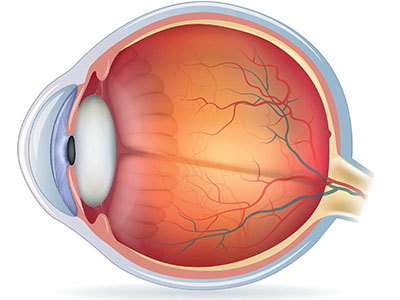RETINA DISEASES

Major Retinal Diseases
The retina is the innermost layer of the eye and forms the basis of vision. Retinal diseases can lead to serious health problems that can lead to vision loss. Here are the main retinal diseases:
- Bleeding Due to Diabetes and High Blood Pressure: Diabetes and hypertension can affect the retinal vessels, leading to hemorrhages and retinal damage.
- Retinal Vein Occlusions: Sudden and permanent vision loss may occur as a result of occlusion of retinal vessels.
- Macular Degeneration (Age-Related Macular Degeneration): This disease, especially seen in older individuals, affects central vision and reduces the ability to see in detail.
- Congenital Retinal Diseases: These diseases, transmitted through genetic factors, can lead to vision loss.
- Foreign Object Penetration into the Eye: Traumatic events that damage the retina can cause vision loss.
- Macular Holes: The formation of a hole in the macula, which is the center of the retina, causes central vision disorders.
- Retinal Tear: It occurs as a result of weakness or thinning of the retinal structure.
- Vitreoretinal Surface Disorders: Abnormal structures between the retina and the vitreous fluid can cause visual disturbances.
- Retinal Vein and Artery Occlusions: Sudden vision loss may occur as a result of occlusion of eye vessels.
- Retinal Detachment: If the retina separates from its lower layer, serious vision loss may occur.
- Neonatal Retinopathy: It is a retinal disease observed in premature babies.
- Retinitis Pigmentosa: It is a genetic disease and causes night blindness and vision loss over time.
- Retinal Tumors: Tumors that form on the retina can threaten vision.
Age-Related Macular Degeneration (Macular Degeneration)
The most common retinal disease is age-related macular degenerationThis disease is particularly common in individuals aged 60 and over, but can also develop in people with a genetic predisposition starting at the age of 45-50. Risk Factors These include smoking, hypertension, cardiovascular diseases and excessive sun exposure.
In macular degeneration, individuals have difficulty seeing centrally while preserving their peripheral vision. This causes problems, especially in recognizing faces or reading written text. Lines and letters may appear distorted, crooked or broken.
Diabetes and Retina Relationship
One of the most important systemic diseases affecting the retina is diabetes. Diabetic retinopathyDiabetes is one of the most common causes of vision loss. Diabetes causes damage to the retina by weakening blood vessels, and this damage can sometimes be permanent.
Symptoms of Retinal Diseases
Retinal diseases usually manifest themselves with the following symptoms:
- Sudden or slowly developing vision loss
- Broken or crooked vision
- flashes of light in the eye
- Floating dark spots (fly flies)
- obscuration of vision
- Poor vision in the dark or in light
- Darkness or shadows in the field of view
If even one of these symptoms is noticed, an ophthalmologist should be consulted immediately.
How is Retinal Examination Done?
It begins with standard procedures such as a retinal examination, vision examination, and intraocular pressure measurement. Then, the pupils are dilated with the help of drops and the retina is examined in detail.
Thanks to this examination, information can be obtained not only about retinal diseases but also about neurological problems such as hypertension, diabetes and even brain tumors. The methods frequently used in the examination are:
- Fundus Fluorescein Angiography: It is a test used to view retinal vessels.
- Optical Coherence Tomography (OCT): It allows detailed examination of the retinal layers.
- Ultrasonography: It is used to view abnormalities in the eye.
Treatment of Retinal Diseases
Treatment of retinal diseases varies depending on the type of disease. Treatment methods include medication/injection, laser treatment and surgical intervention.
- In dry type macular degeneration While no treatment is usually required, wet type Intraocular injections or laser treatment may be applied to prevent vision loss.
- retinal tearsIt is a serious problem that can lead to blindness. In this case, surgical methods are used depending on the size of the tear.
- Diabetic retinopathyWhen diagnosed early, it can be controlled with laser treatment or intraocular injections. However, if it is too late, surgical intervention may be required.
Early diagnosis of retinal diseases plays a critical role in preventing permanent vision loss. It is especially important for individuals in the older age group not to skip regular eye examinations.

